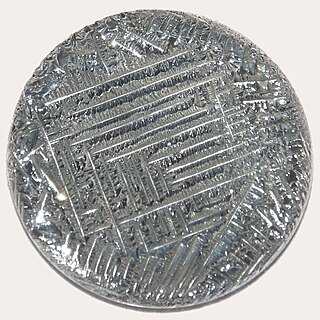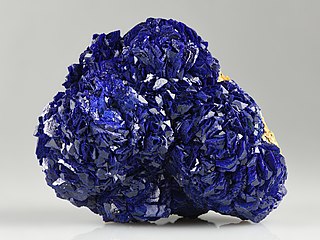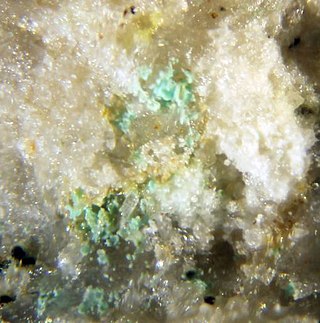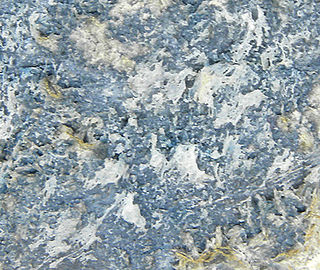Related Research Articles

Tellurium is a chemical element; it has symbol Te and atomic number 52. It is a brittle, mildly toxic, rare, silver-white metalloid. Tellurium is chemically related to selenium and sulfur, all three of which are chalcogens. It is occasionally found in its native form as elemental crystals. Tellurium is far more common in the Universe as a whole than on Earth. Its extreme rarity in the Earth's crust, comparable to that of platinum, is due partly to its formation of a volatile hydride that caused tellurium to be lost to space as a gas during the hot nebular formation of Earth.

Vanadinite is a mineral belonging to the apatite group of phosphates, with the chemical formula Pb5(VO4)3Cl. It is one of the main industrial ores of the metal vanadium and a minor source of lead. A dense, brittle mineral, it is usually found in the form of red hexagonal crystals. It is an uncommon mineral, formed by the oxidation of lead ore deposits such as galena. First discovered in 1801 in Mexico, vanadinite deposits have since been unearthed in South America, Europe, Africa, and North America.

Azurite is a soft, deep-blue copper mineral produced by weathering of copper ore deposits. During the early 19th century, it was also known as chessylite, after the type locality at Chessy-les-Mines near Lyon, France. The mineral, a basic carbonate with the chemical formula Cu3(CO3)2(OH)2, has been known since ancient times, and was mentioned in Pliny the Elder's Natural History under the Greek name kuanos (κυανός: "deep blue," root of English cyan) and the Latin name caeruleum. Copper (Cu2+) gives it its blue color.

Pyromorphite is a mineral species composed of lead chlorophosphate: Pb5(PO4)3Cl, sometimes occurring in sufficient abundance to be mined as an ore of lead. Crystals are common, and have the form of a hexagonal prism terminated by the basal planes, sometimes combined with narrow faces of a hexagonal pyramid. Crystals with a barrel-like curvature are not uncommon. Globular and reniform masses are also found. It is part of a series with two other minerals: mimetite (Pb5(AsO4)3Cl) and vanadinite (Pb5(VO4)3Cl), the resemblance in external characters is so close that, as a rule, it is only possible to distinguish between them by chemical tests. They were formerly confused under the names green lead ore and brown lead ore (German: Grünbleierz and Braunbleierz).

Mimetite is a lead arsenate chloride mineral (Pb5(AsO4)3Cl) which forms as a secondary mineral in lead deposits, usually by the oxidation of galena and arsenopyrite. The name derives from the Greek Μιμητής mimetes, meaning "imitator" and refers to mimetite's resemblance to the mineral pyromorphite. This resemblance is not coincidental, as mimetite forms a mineral series with pyromorphite (Pb5(PO4)3Cl) and with vanadinite (Pb5(VO4)3Cl). Notable occurrences are Mapimi, Durango, Mexico and Tsumeb, Namibia.

Barytocalcite is an anhydrous barium calcium carbonate mineral with the chemical formula BaCa(CO3)2. It is trimorphous with alstonite and paralstonite, that is to say the three minerals have the same formula but different structures. Baryte and quartz pseudomorphs after barytocalcite have been observed.

Enargite is a copper arsenic sulfosalt mineral with formula Cu3AsS4. It takes its name from the Greek word enarge, "distinct". Enargite is a steel gray, blackish gray, to violet black mineral with metallic luster. It forms slender orthorhombic prisms as well as massive aggregates. It has a hardness of 3 and a specific gravity of 4.45.

Polyhalite is an evaporite mineral, a hydrated sulfate of potassium, calcium and magnesium with formula: K2Ca2Mg(SO4)4·2H2O. Polyhalite crystallizes in the triclinic system, although crystals are very rare. The normal habit is massive to fibrous. It is typically colorless, white to gray, although it may be brick red due to iron oxide inclusions. It has a Mohs hardness of 3.5 and a specific gravity of 2.8. It is used as a fertilizer.

Cesbronite is a copper-tellurium oxysalt mineral with the chemical formula Cu3Te6+O4(OH)4 (IMA 17-C). It is colored green and its crystals are orthorhombic dipyramidal. Cesbronite is rated 3 on the Mohs Scale. It is named after Fabien Cesbron (born 1938), a French mineralogist.
Clearcreekite is a carbonate mineral, polymorphous with peterbaylissite. The chemical formula of clearcreekite is Hg(1+)3CO3(OH)∙2H2O. It has a pale greenish yellow color and streak with tabular subhedral crystals and good cleavage on {001}. It is transparent with vitreous luster and uneven fracture. Its density (calculated from the idealized formula) is 6.96 g/cm3. The mineral is monoclinic with the space group P2/c. Clearcreekite is an extremely rare mineral from the Clear Creek mercury mine, New Idria district, San Benito County, California. It was probably formed after the alteration of other mercury minerals such as cinnabar. The mineral is named after the locality where it was found.

Zemannite is a very rare oxide mineral with the chemical formula Mg0.5ZnFe3+[TeO3]3·4.5H2O. It crystallizes in the hexagonal crystal system and forms small prismatic brown crystals. Because of the rarity and small crystal size, zemannite has no applications and serves as a collector's item.

Walfordite is a very rare tellurite mineral that was discovered in Chile in 1999. The mineral is described as orange with orange-yellow streak, and is determined to have a chemical formula of Fe3+,Te6+Te4+3O8 with minor titanium and magnesium substitution resulting in an approximate empirical formula of (Fe3+,Te6+,Ti4+,Mg)(Te4+)3O8.

Tlapallite is a rare and complex tellurate mineral with the chemical formula (Ca,Pb)3CaCu6[Te4+3Te6+O12]2(Te4+O3)2(SO4)2·3H2O. It has a Moh's hardness of 3 and it is green in colour. It was named after the Nahua word "Tlalpalli", which translates to paint, referring to the paint-like habit of the mineral. Its formula and crystal structure were redefined in 2019, showing it contained a mixed-valence phyllotellurate layer [Te4+3Te6+O12]12−.

Carlfriesite is a rare tellurium mineral with the formula CaTe4+2Te6+O8, or more simplified: CaTe3O8. It has a Moh's hardness of 3.5 and it occurs in various shades of yellow, ranging from bright yellow to a light buttery color. It was named after Carl Fries Jr. (1910–1965) from the U.S. Geological Survey and the Geological Institute of the National University, Mexico City, Mexico. It was previously thought to have the formula H4Ca(TeO3)3, but this was proven to be incorrect. It has no uses beyond being a collector's item.

Teineite is a tellurite mineral with the formula Cu(TeO3). 2 H2O. It has a Mohs hardness of 2.5 and it comes in many different shades of blue, ranging from cerulean blue to bluish-gray. The mineral millsite has the same chemical composition, but crystallizes in the monoclinic system, while teineite crystallizes in the orthorhombic system.
Scotlandite is a sulfite mineral first discovered in a mine at Leadhills in South Lanarkshire, Scotland, an area known to mineralogists and geologists for its wide range of different mineral species found in the veins that lie deep in the mine shafts. This specific mineral is found in the Susanna vein of Leadhills, where the crystals are formed as chisel-shaped or bladed. Scotlandite was actually the first naturally occurring sulfite, which has the ideal chemical formula of PbSO3. The mineral has been approved by the Commission on New Minerals and Mineral Names, IMA, to be named scotlandite for Scotland.
Bluebellite is a mineral discovered in 2013 in the Blue Bell Mine in the Mojave Desert, California at the same time as the discovery of mojaveite. This mineral was named after its locality, since the Blue Bell Mine claims most of the surrounding area. The only observed forms of this mineral are the {001} and {001}. Bluebellite is known to form bright bluish-green flattened plates or flakes that are range up to 20 x 20 x 5 nm in size, commonly inter-grown in irregular aggregates. Bluebellite and mojaveite are very similar in structure, they are only differentiated by their unique mineral composition.
Elgoresyite, first discovered during the crystallographic study of the Suizhou meteorite, is a naturally occurring, high-pressure iron-magnesium silicate mineral. High-pressure poly morphs of magnesium silicates have been rarely discovered on Earth, due to retrograding as they ascend to the surface. It is named after Ahmed El Goresy.

Olmiite is a rare calcium-manganese silicate that was named after an Italian mineralogist called Filippo Olmi. It was approved by the IMA in 2006, being first published in 2007, which makes it a relatively newly discovered mineral. Around 2001, a large amount of specimens believed to be poldervaartite was discovered at the N'Chwaning II mine, which is near the Wessels mine, where the latter was discovered. Only later were the researchers able to determine through their investigations that the two minerals are different, as they are visually indistinguishable. Until Renato Pagano acquired and examined the specimens, seemingly no specific investigation was carried out. Olmiite has been misidentified not only once, but twice. The cream-colored specimens were at first thought to be baryte by the mine geologist.

Ilsemannite is an uncommon amorphous complex heterovalent molybdenum oxide, that was first published in 1871, and has been a valid species since pre-IMA. It is a grandfathered mineral, meaning the name ilsemannite is still believed to refer to a valid species. However, it is likely that specimens formed under different conditions, in different localities do not have the same composition, and may even be a mixture of compounds. Furthermore, it is hard to analyze the specimens due to them being a mixture, hence why adequate analyses are lacking of said mineral. Ilsemannite is believed to be identical to synthetic molybdic oxide.
References
- ↑ Warr, L.N. (2021). "IMA–CNMNC approved mineral symbols". Mineralogical Magazine. 85 (3): 291–320. Bibcode:2021MinM...85..291W. doi: 10.1180/mgm.2021.43 . S2CID 235729616.
- 1 2 3 4 5 6 7 8 9 10 Kampf, Anthony R.; Housley, Robert M.; Rossman, George R. (2020-07-01). "Northstarite, a new lead-tellurite-thiosulfate mineral from the North Star mine, Tintic, Utah, USA". The Canadian Mineralogist. 58 (4): 533–542. Bibcode:2020CaMin..58..533K. doi:10.3749/canmin.1900105. ISSN 1499-1276. S2CID 225626916.
- 1 2 3 4 5 "Northstarite". www.mindat.org. Retrieved 2021-12-12.